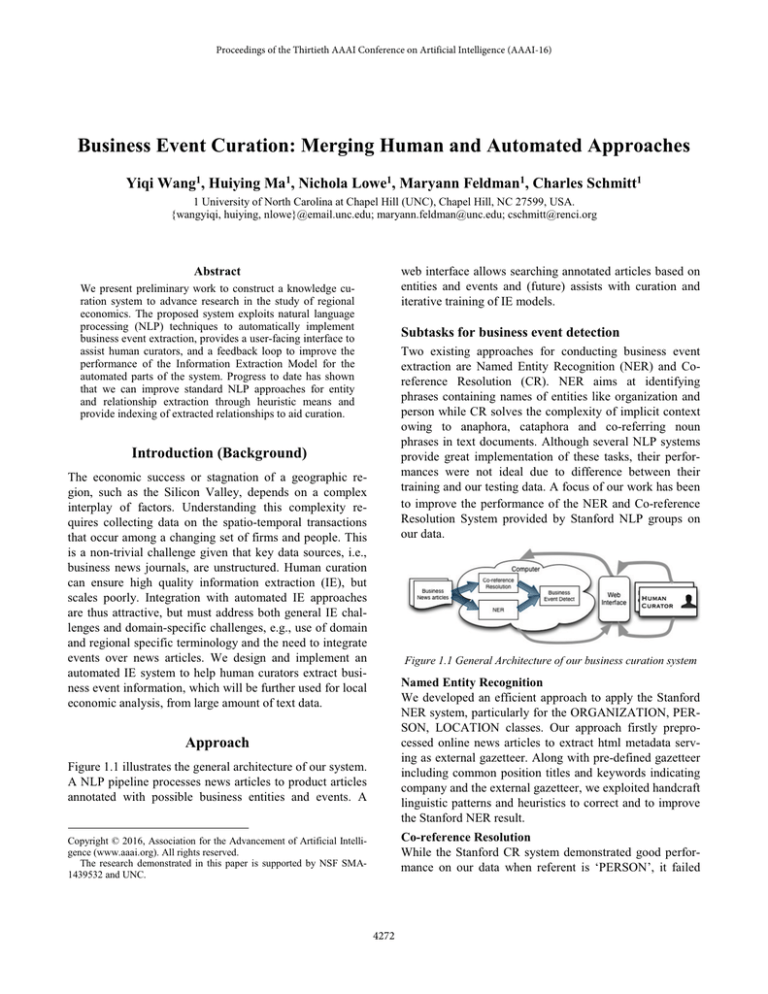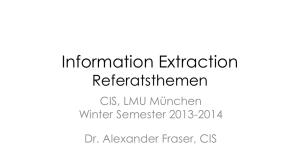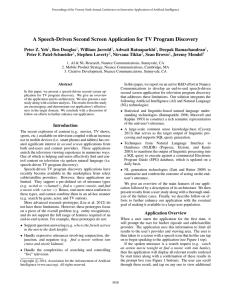
Proceedings of the Thirtieth AAAI Conference on Artificial Intelligence (AAAI-16)
Business Event Curation: Merging Human and Automated Approaches
Yiqi Wang1, Huiying Ma1, Nichola Lowe1, Maryann Feldman1, Charles Schmitt1
1 University of North Carolina at Chapel Hill (UNC), Chapel Hill, NC 27599, USA.
{wangyiqi, huiying, nlowe}@email.unc.edu; maryann.feldman@unc.edu; cschmitt@renci.org
web interface allows searching annotated articles based on
entities and events and (future) assists with curation and
iterative training of IE models.
Abstract
We present preliminary work to construct a knowledge curation system to advance research in the study of regional
economics. The proposed system exploits natural language
processing (NLP) techniques to automatically implement
business event extraction, provides a user-facing interface to
assist human curators, and a feedback loop to improve the
performance of the Information Extraction Model for the
automated parts of the system. Progress to date has shown
that we can improve standard NLP approaches for entity
and relationship extraction through heuristic means and
provide indexing of extracted relationships to aid curation.
Subtasks for business event detection
Two existing approaches for conducting business event
extraction are Named Entity Recognition (NER) and Coreference Resolution (CR). NER aims at identifying
phrases containing names of entities like organization and
person while CR solves the complexity of implicit context
owing to anaphora, cataphora and co-referring noun
phrases in text documents. Although several NLP systems
provide great implementation of these tasks, their performances were not ideal due to difference between their
training and our testing data. A focus of our work has been
to improve the performance of the NER and Co-reference
Resolution System provided by Stanford NLP groups on
our data.
Introduction (Background)
The economic success or stagnation of a geographic region, such as the Silicon Valley, depends on a complex
interplay of factors. Understanding this complexity requires collecting data on the spatio-temporal transactions
that occur among a changing set of firms and people. This
is a non-trivial challenge given that key data sources, i.e.,
business news journals, are unstructured. Human curation
can ensure high quality information extraction (IE), but
scales poorly. Integration with automated IE approaches
are thus attractive, but must address both general IE challenges and domain-specific challenges, e.g., use of domain
and regional specific terminology and the need to integrate
events over news articles. We design and implement an
automated IE system to help human curators extract business event information, which will be further used for local
economic analysis, from large amount of text data.
Figure 1.1 General Architecture of our business curation system
Named Entity Recognition
We developed an efficient approach to apply the Stanford
NER system, particularly for the ORGANIZATION, PERSON, LOCATION classes. Our approach firstly preprocessed online news articles to extract html metadata serving as external gazetteer. Along with pre-defined gazetteer
including common position titles and keywords indicating
company and the external gazetteer, we exploited handcraft
linguistic patterns and heuristics to correct and to improve
the Stanford NER result.
Approach
Figure 1.1 illustrates the general architecture of our system.
A NLP pipeline processes news articles to product articles
annotated with possible business entities and events. A
Co-reference Resolution
While the Stanford CR system demonstrated good performance on our data when referent is ‘PERSON’, it failed
Copyright © 2016, Association for the Advancement of Artificial Intelligence (www.aaai.org). All rights reserved.
The research demonstrated in this paper is supported by NSF SMA1439532 and UNC.
4272
most of cases referring to ‘ORGANIZATION’ entity. We
proposed a naïve approach to solve co-reference issue with
‘ORGANIZATION’ entity in particular. Similar to but
simpler
than
the
approach
implemented
in
Hobbs (1978), the proposed approach adopted syntax features, namely Part of Speech (POS) and parse tree to solve
the problem. In brief, we mainly deployed steps as follow:
For definite articles such as ‘the company’, we search entity in the dominated ‘NP’ (noun phrase) of the previous
sentence. As for pronouns, we first search entity in the directly dominated ‘NP’ of the pronoun in the same sentence
and then follow the method we use for definite articles.
The XML files can easily uploaded to Solr by sending
HTTP requests to the Solr server from any environment
where such requests can be generated and we can also use
HTTP request to retrieve information indexed on Solr.
Web Interface Design
To support category-based search, we decided to design
the web interface with a main general search bar with an
advanced search panel listed with filters such as location,
organization and other classes detected by the IE model.
There would also be a result page with all the retrieved
documents and the link to open the original HTML file for
curators to mark and annotate in the future.
Business event extraction
Preliminary Result and Future Work
We have adopted rule-based methods using both lexical
and syntax features to extract information about business
events, principally the concepts of IPO (initial public offering), layoff and investment. A key challenge is that these
concepts are described with a variety of syntax (e.g., "going public"). The general architecture consists two steps:
identifying phrases serving as event trigger and extracting
potential event participants. Depending on event type, we
applied either lexicon dominated patterns or syntax dominated patterns. For instance, some event information such
as "investment project", did not belong to any named entity, which is hard to write surface pattern. However, syntax
feature worked well in this situation. Additionally, syntax
feature can partially eliminate noises brought by clause or
other complex sentence structure. The form of our event
patterns is similar to the patterns constructed in Liu (2009).
We used 25 news articles, 9689 words in total, as preliminary test data for our improved NER approach. As Table1.1 suggests, our approach we significantly improved
the Stanford NER system performance on our data set.
Named Entity
Improved NER
Stanford NER
P
R
F1
P
R
F1
LOCATION
0.99
0.93
0.96
0.91
0.83
0.87
ORGANIZATION
0.94
0.88
0.91
0.97
0.50
0.66
PERSON
0.70
0.98
0.82
0.52
0.95
0.67
Table 1.1 Comparison of Stanford NER vs. Our approach
For other event extraction tasks, we conducted initial
qualitative assessment since quantitative evaluation requires large labeled data sets that we have yet to generate.
We plan to both increase the size of our training sets for
these tasks as well as investigate the use of distant supervision for further evaluation. Finally, we will be evaluating
the impact of our system on the performance of human
curators as our principal assessment of utility. In
future
work, we plan to explore the learning-based approach for
event detection without requiring large-scale labeled data,
drawing upon feedback gathered from human curators as
they extract entities and relationships. We also plan to investigate inference models to improve NLP.
Curation Web Application Design
As a first step towards a curation tool for researchers, we
have designed a web interface for curators to search and
browse the business information processed by the Information Extraction Model.
Data Source
The web application takes the documents automatically
generated by using the IE Model as CSS marked-up
HTML files. All the classes detected in each documents are
marked in different colors using different CSS “class”es
and “id”s.
References
Document Indexing Method
We use Apache Solr as the full-text indexing tool for this
system considering the file amounts, the retrieval speed
and the powerful indexing and searching functions Apache
Solr can provide, such as field matching, faceting and query re-ranking. We mapped the contents of the HTML files
into different fields according to their classes detected by
the IE model using a python script and generated corresponding standard indexing XML files.
Hobbs, J. R. 1976a. Pronoun Resolution. Research Report 76-1,
Department of Computer Sciences, City College, City University
of New York.
Liu, Ting. 2009. Bootstrapping events and relations from text.
Ph.D. diss., Department of Computer Science, State University of
New York at Albany, Albany, NY.
Agichtein, E., & Gravano, L. 2000, June. Snowball: Extracting
relations from large plain-text collections. In Proceedings of the
fifth ACM conference on Digital libraries (pp. 85-94). ACM.
4273




